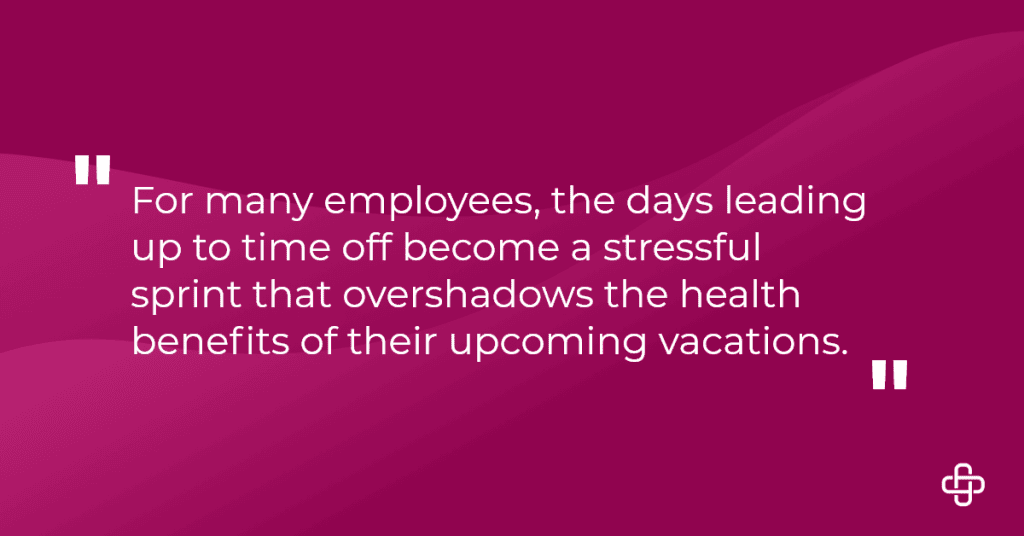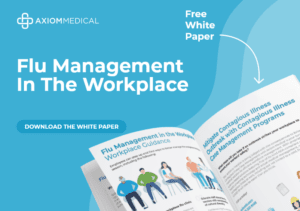Despite all the merry-making and vacation time, the holiday season can be hard. Unique winter stressors, both emotional and physical, invariably impact employees in both their personal and professional lives. Whether employers are seasonal celebrants or not, it’d be wise for them to acknowledge these holiday hardships because absenteeism typically spikes sharply during this period.

In anticipation of our upcoming webinar Under Pressure: Hidden Health Costs of the Holidays, we’ll consider some of these season-specific dangers and explore winter safety precautions employers can take to prevent them.
Table of Contents
| 1. Shedding Light on SAD |
| 2. Dashing Through the Snow |
| 3. Holiday Hustle |
| 4. The Gift that Keeps on Taking |
1. Shedding Light on SAD
There’s a wonderful scene in How the Grinch Stole Christmas (2000) where Jim Carrey’s Grinch, upon receiving an invitation from the Whos of Whoville, ponders his winter schedule:
“4:00, wallow in self-pity. 4:30, stare into the abyss. 5:00, solve world hunger, tell no one. 5:30, jazzercize; 6:30, dinner with me. I can’t cancel that again. 7:00, wrestle with my self-loathing. I’m booked.”
While this example is clearly over-the-top, it also illustrates how Seasonal Affective Disorder (SAD) can cause gloominess and unproductivity in people. When Daylight Saving Time occurs and the sun begins setting around 4 PM, the lack of sunlight disrupts the chemicals in our brain, causing general feelings of moodiness and lethargy.
Employers should be cognizant that employees affected by SAD may display temporary forgetfulness, irritability, and dips in their discretionary efforts. Before taking action, employers should consider whether these behaviors may naturally improve in the spring. If this seems likely, and employees are solid performers during the rest of the year, then the best fix may be to practice patience and gently remind employees to stay mindful of workplace safety protocol despite the winter slump. And in the meantime, employers can further support their teams by maximizing employee exposure to light—whether through natural or artificial sources. These extra efforts may help prevent SAD-induced negligence.
2. Dashing Through the Snow
Whether workers are commuting in Duluth or Dallas, they’ll likely encounter difficult road conditions at least once during the holiday season. And when winter weather strikes, getting to the job site safely can be a job in itself. Scraping ice off the windshield, engine issues, and challenging traffic can significantly increase winter commuting hassles and hazards.
Employers should respond to winter weather events with a safety-first mindset. Share reminders and tips for safe driving on icy roads. In warmer climates, where sleet, snow, and freezing temperatures are an infrequent occurrence, it may be beneficial for employers to gift employees items that promote safety, such as ice scrapers and emergency blankets.
Flexibility is also paramount in helping employees safely navigate a treacherous winter commute. Employers should regularly check in with their team to see how their morning drive is going and make clear that safe driving takes precedence over clocking in exactly on time.
3. Holiday Hustle
Isn’t it funny how sometimes people go on vacation and a lingering health issue they’ve been dealing with suddenly evaporates? Well, the data on vacations is no laughing matter—they’ve been proven to reduce cardiovascular events.
The ROI of vacations checks out. Giving our minds and bodies a chance to decompress helps employees avoid burnout and return to work with heightened focus and energy. But the caveat here is that, for many employees, the days leading up to time off become a stressful sprint that overshadows the health benefits of their upcoming vacations. This one-step-forward, two-steps-back scenario can negatively impact individual employee health outcomes as well as the team’s overall well-being.
Stress is a silent killer. It exacerbates existing health conditions and creates new ones. Considering that 89% of adults feel stressed during the holiday season and 41% report that this stress is more severe than at other times of the year, it’s worth taking steps to lessen the pre-vacation crunch.
Employers can prevent this crunch by setting realistic workload expectations for the holiday season. By adjusting the schedule in advance to account for winter days off and spreading the workload evenly before and after the holidays, employers can help prevent employees from becoming overwhelmed. And they should avoid emulating the infamous employer Ebenezer Scrooge, who insisted that his employee come in early the day after Christmas to make up for the perceived dip in productivity.
4. The Gift that Keeps on Taking
By now, employers are painfully aware of how viruses can derail employees and their teams. It’s easy to let the fatigue from the last few years slip into complacency, but employers must continue to stay vigilant against viral threats. The holiday season is particularly fraught, as lower temperatures, more indoor gatherings, and reduced ventilation all make a perfect breeding ground for germs to spread. When combined with end-of-year stress and vacations, illnesses can have a compounding effect, leading to higher absenteeism and disrupted workflows.
When dealing with these invisible enemies, the best defense is common sense. Place hand sanitizers in common areas and frequently clean high-touch surfaces like desks and door handles. Try to increase air ventilation in inside areas by opening windows (weather permitting) or investing in air purifiers. Encourage (or better yet, incentivize) employees to keep their immune systems healthy through adequate nutrition, daily exercise, and annual vaccinations.
Despite employers’ best efforts, communicable diseases may still infiltrate the workplace. Instead of throwing their hands up in exasperation, employers should pat themselves on the back for minimizing the viral load among their employees and set up policies to further reduce transmission. When possible, employers should implement sick leave policies that curb a culture of presenteeism. Discouraging coming to work sick will prevent nightmare scenarios where entire teams fall ill. Furthermore, employers should show appreciation for employees who take precautions. This will reassure them that health comes first and will go a long way towards creating a healthier (and more resilient) team.
Just the Tip of the Iceberg
The best intervention is prevention. And these four holidangers are just the tip of the iceberg. If you want to learn more about winter workplace safety, watch our recent webinar Under Pressure: Health Hazards of the Holidays, where Dr. Scott Cherry dives into the data behind these unique seasonal challenges and provide actionable steps to get in front of them.










